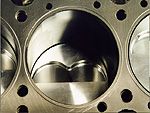
If running faster each season in your Pontiac is the credo by which you live, then there will come a time when your engine combination reaches a power level that causes a set of head gaskets to fail after just a few runs. At this point, about 650 horsepower, according to engine builder and HPP contributor Jim Taylor, it's time to O-ring the engine to keep the water and combustion contained.
Jim explained that the Pontiac engine is at somewhat of a disadvantage with regard to cylinder to head sealing in race engines due to the fact that it only has 10 head bolts per side, whereas a big-block Chevy, for example, has 16. Also, Pontiacs are thin cast so things can move around under high cylinder pressures. When the head gaskets do give up in a Pontiac, they tend to leak water more than actual cylinder pressure but neither is a good thing at 135-plus mph through the traps. In Taylor's experience, many engines producing 650-plus hp get only 5-20 passes before the head gaskets fail, unless O-rings are employed.
If this scenario is all too familiar for you, then it's time to O-ring your race engine. Jim related that it's easier for the Ford and Chevy guys because gaskets are manufactured with the O-rings already in them. However, no company that we could find makes such gaskets for Pontiacs. So, how do you O-ring your Pontiac engine? Should you groove the block or heads to accept the O-rings? Is this a process that you can complete on your own when you assemble the engine? These questions and more will be addressed in the following captions.